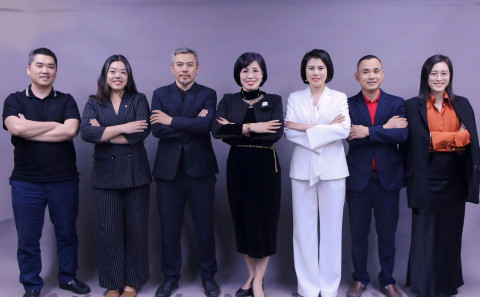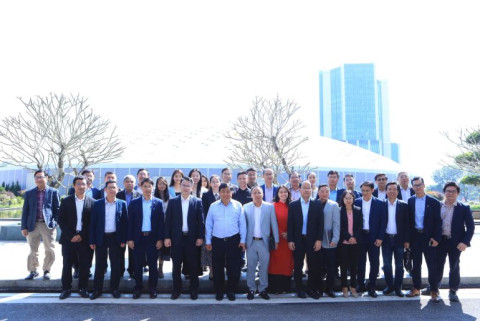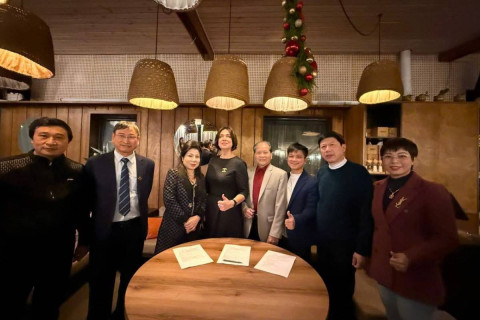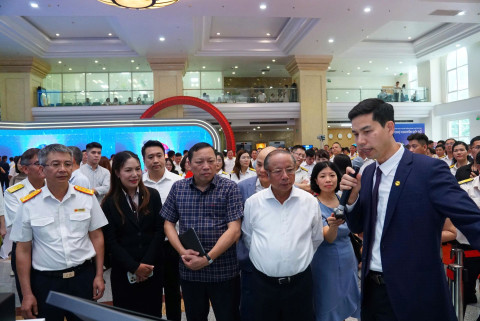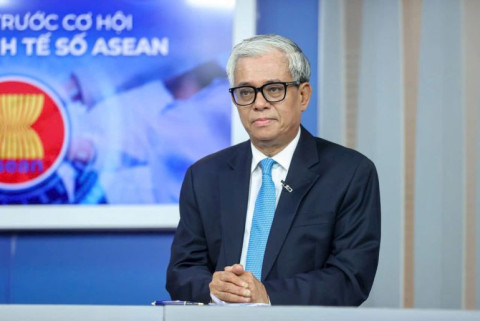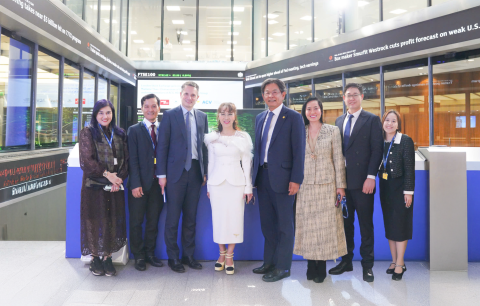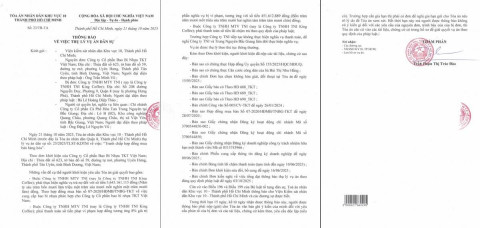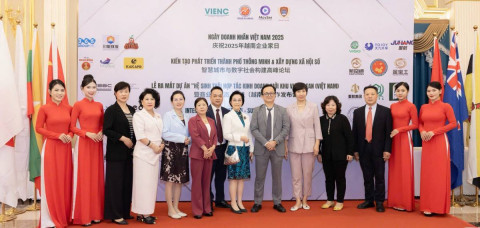Vietnam - The "Eagle’s" Second Home
- 151
- Business
- 13:21 04/01/2024
DNHN - Upon his arrival in Vietnam, billionaire Jensen Huang, Chairman and CEO of Nvidia Corporation, expressed his desire to transform Vietnam into Nvidia’s "second home."
This statement has inspired investors, but how many “eagles” are interested in making Vietnam their second home, and what must be done to attract them?
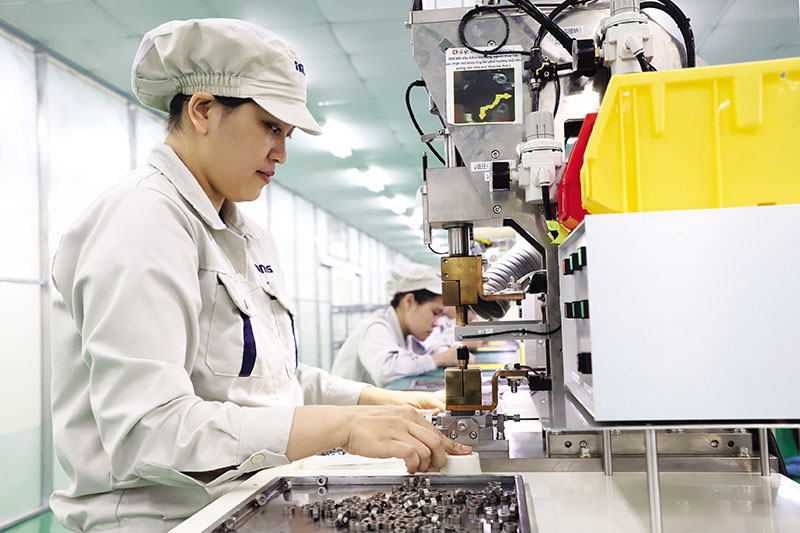
A Bright Piece of the Puzzle
From being a significant concern at the beginning of the year, attracting foreign investment unexpectedly emerged as a bright spot in the economic picture of 2023. In late December 2023, since the Foreign Investment Agency (Ministry of Planning and Investment) announced that in 2023, Vietnam had registered USD 36.61 billion in foreign investment capital, while disbursed capital reached a record of nearly USD 23.2 billion, this has been widely discussed.
On the morning of December 29, 2023, when the General Statistics Office held a press conference on the socio-economic situation in 2023, attracting foreign investment also became a major concern, although, in reality, this issue has rarely been mentioned in such meetings in the past. However, this is understandable, as the figure of USD 36.61 billion, representing a 32.1% increase compared to the same period in 2022, is truly impressive. Notably, of this amount, newly registered capital reached nearly USD 20.2 billion, an increase of 62.2% year-on-year. Meanwhile, investment capital through capital contribution and share purchase reached over USD 8.5 billion, up 65.7%. All of these are impressive growth rates.
In fact, at the beginning of 2023, in a discussion with a reporter from Vietnam Investment Review, Mr Do Van Su, Deputy Director of the Foreign Investment Agency, predicted that foreign investment attraction in 2023 could reach USD 36-38 billion, while disbursed capital would be around USD 22-23 billion. One of the reasons is that China’s opening up of its economy would positively impact Vietnam’s foreign investment attraction.
“In the region, China remains the top investment destination, so when they open up, capital will flow into this market, limiting the inflow into Vietnam and other economies. On the contrary, the shift of investment capital from South Korea, Japan, Taiwan, etc. out of China will be accelerated. This shift will be accelerated until 2025,” said Mr Do Van Su.
However, perhaps until the last months of 2023, especially in the first half of the year, few believed that such a figure could be achieved. After all, in the first 6 months, the figure was only USD 13.43 billion in registered capital, a decrease of 4.3% compared to the same period in 2022. It was not until LG Innotek’s project in Hai Phong with an additional capital of over USD 1 billion was recorded that foreign investment in Vietnam began to “reverse.” After 7 months, the figure reached nearly USD 16.24 billion, an increase of 4.5% compared to the same period in 2022.
Since then, the trend has become increasingly positive, especially as large-scale projects continue to receive investment. From the JINKO Solar Hai Ha photovoltaic cell complex project with an investment capital of USD 1.5 billion; to the Lite-ON project worth USD 690 million in Quang Ninh; then the USD 500 million project of SK in Hai Phong; the deal in which Sumitomo Mitsui Banking Corporation spent USD 1.5 billion to buy shares of VPBank; and most recently, the nearly USD 2 billion power project in Thai Binh… All of these have contributed bright pieces to the economic picture of 2023.
“Vietnam continues to be a safe and attractive destination for investors,” commented Mr Do Nhat Hoang, Director of the Foreign Investment Agency.
Vietnam has continued to achieve great success in attracting foreign investment after more than 35 years of effort.
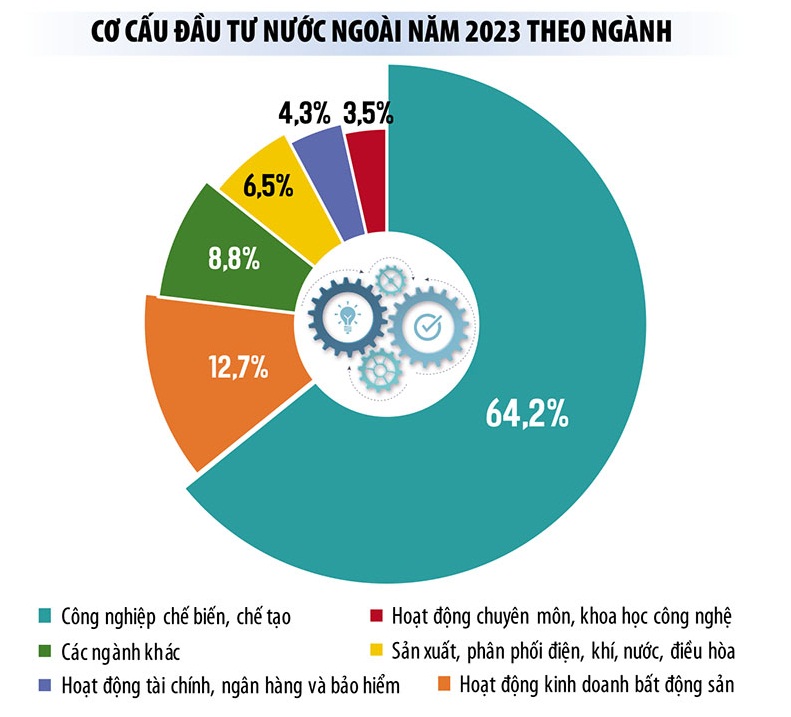
A Second Home
The figures, especially the record disbursed capital, have generated great excitement. However, this excitement probably resonates more with state management agencies and policymakers.
Domestic and foreign investors and businesses are likely more enthusiastic about the high-level visits to Vietnam by US President Joe Biden, Chinese President Xi Jinping, South Korean President Yoon Suk Yeol, and other national leaders; as well as overseas trips by the country’s leaders. Along with these visits, investment and business cooperation opportunities have opened up, broader than ever before.
During President Joe Biden’s visit alone, when the two countries decided to focus their cooperation on innovation, science, and technology, including semiconductors and AI, billion-dollar opportunities were established. A series of big names, such as Intel, Qualcomm, Ampere, ARM, Synopsys, Infineon, Marvell, etc., continued to seek out Vietnam to initiate strategic cooperation opportunities.
Han Micron also inaugurated a new factory with an investment of USD 600 million, which will be increased to USD 1 billion in the coming years. Amkor has put phase I of its USD 1.6 billion plant into operation. Synopsys, Marvell, Nvidia, etc., have also been exploring new cooperation possibilities in Vietnam.
“We see incredible opportunities for Vietnam to develop its footprint in the global semiconductor supply chain,” said John Neuffer, President of the American Semiconductor Industry Association.
However, such “incredible” opportunities are not limited to the semiconductor industry alone but also high-tech industries in general. Therefore, a series of investment and production expansion plans in Vietnam by Foxconn, Compal, Goertek, Luxshare, Samsung, LG, etc., have been and are being implemented.
Mr John Neuffer mentioned the “flourishing” of the semiconductor market in 2023 after the difficulties during the Covid-19 pandemic had passed. Vietnam also seems to be “flourishing” in attracting foreign investment.
Right after the visit to Vietnam by the delegation of the American Semiconductor Association, billionaire Jensen Huang, Chairman and CEO of Nvidia Corporation, arrived in Vietnam. This visit immediately created a significant buzz in the global technology community and investment circles. After all, Jensen Huang is the “wizard” of the global AI industry. Moreover, Nvidia’s growth has been remarkable, with its market capitalisation reaching the USD 1 trillion mark by the end of May 2023.
“We are committed to doing our best to make Vietnam Nvidia’s second home. We will establish a legal entity in Vietnam,” said Jensen Huang during his visit to Vietnam.
And this has created excitement and great inspiration for investors. Although Jensen Huang’s statement has not yet become a reality, the question arises: how many more “eagles” want to make Vietnam their second home?
In fact, this number is not small. For many years, Samsung has considered Vietnam its second home, and that is why this investor has poured USD 20 billion into the Vietnamese market, making Vietnam not only an investment stronghold but also an R&D stronghold.
“We will contribute to building our second home by striving for Vietnam’s development, such as supporting the development of the supporting industry in Vietnam,” said Choi Joo Ho, General Director of Samsung Vietnam, adding that the philosophy of “shared prosperity” has always been Samsung’s endeavour since its early days in Vietnam.
Without explicitly stating that Vietnam is a “second home,” Mr Furusawa Yasuyuki, a member of the Board of Directors of AEON Corporation (Japan) in charge of the Vietnamese market and General Director of AEON Vietnam, said that for AEON, Vietnam is the “second most important market” after Japan. Therefore, AEON is still accelerating its investment and recently signed a cooperation agreement to open large shopping centres in Can Tho and Bac Giang. The investment capital for these two centres could reach USD 500 million.
Meanwhile, Foxconn, Goertek, and Intel all consider Vietnam one of their most important production bases. They continue to invest in the highly potential Vietnamese market.
Attracting “Eagles” to Build Nests
In late 2023, Intel decided to invest in Israel in a project worth up to USD 25 billion. Although this information had been rumoured before, the figure of USD 25 billion surprised observers. Reuters reported that to receive this project, the Israeli Government agreed to provide Intel with a grant of up to USD 3.2 billion, equivalent to 12.8% of the project’s total investment capital.
This story is similar to what happened earlier when both Poland and Germany made significant support commitments to receive major Intel projects. In Poland, the commitment was USD 4.6 billion, while in Germany, it was EUR 30 billion (USD 33 billion). Meanwhile, there is information that Intel has cancelled its phase II investment plan in Vietnam.
Although the information has not been confirmed, it shows that competition to attract investment is becoming increasingly fierce. Vietnam’s “competitors” will not only be economies in the region, such as Thailand, Malaysia, India, and even China, but also further afield.
In its latest report, the Macroeconomic Steering Group 1317 stated that although a new wave of investment is expected to open up for Vietnam, especially after the cooperation commitments of US partners, and although Vietnam is still one of the preferred choices, the challenges are also significant. This is because it is predicted that in 2024, the global foreign investment outlook may be more uncertain, affecting the trend of capital movement, including the trend of “repatriation,” production relocation closer to home and to close allied countries.
In addition, according to the Macroeconomic Steering Group 1317, from January 1, 2024, Vietnam will also join the global minimum tax “playground.” Therefore, the government needs to promptly issue policies to attract and retain investors, as well as support businesses in seizing new opportunities from the shift in production supply chains, attracting more multinational corporations to invest in new fields such as semiconductor chips, AI, etc.
The Ministry of Planning and Investment is drafting a Decree on the establishment, management, and use of the Investment Support Fund, to attract and retain “eagles,” especially in the high-tech sector. “Recently, the National Assembly issued a Resolution allowing the Government to develop a Decree to establish an investment support fund for many high-tech projects, including semiconductor industry projects. We are actively developing the decree and will soon issue it by mid-2024,” said Nguyen Chi Dung, Minister of Planning and Investment.
However, along with incentive mechanisms, what investors need is also readiness in terms of land, infrastructure, human resources, and further drastic reforms in administrative procedures, the investment environment, as well as the development of the supporting industry, and even the growth of the domestic business sector, to be strong enough to become their partners in the global game.
Nguyen Duc
Related news
- Connecting Leaders, Shaping the Future: Strategic Leadership Planning Meeting – CorporateConnections Hanoi A
- Sunlight - Unilever Vietnam Recognized for Outstanding Contributions to the National Initiative Supporting Women Entrepreneurs
- Deputy Prime Minister Nguyễn Chí Dũng: “The country’s major challenges weigh heavily on my mind — and we must resolve them together.
- Unitsky String Technologies signs cooperation agreements with three Vietnamese partners, opening a new direction for smart mobility and sustainable development
- When artists do business – livelihood is no poetry!
- Before the D‑day to abolish flat‑rate tax: Fear of technology and costs leave small traders struggling to adapt
- Vietnamese enterprises at a crossroads: the impact of a potential US–China deal
- "Digital technicians" must not be forgotten if Vietnam aims to meet its strategic goals
- HDBank: Impressive profit growth, leading in profitability and advancing international integration
- TNI King Coffee sued for over VND 5 Billion in unpaid debts
- VINASME and Jeonnam Technopark Sign MOU on technology cooperation, human resource training, and trade promotion
- Vietnamese entrepreneurs strengthen ASEAN connectivity in the digital iIntegration era
- Prime Minister: Vietnam aims to become a regional logistics hub
- Vietnam upgraded to Secondary Emerging Market by FTSE Russell
- Hanoi’s economy grows 7.92% in first nine months of 2025, FDI surges nearly threefold
- Vietnam’s strong gdp growth fails to ease labor market distress
- US tariffs on Brazil propel Vietnam’s pangasius into global spotlight
- VietLeap AI Accelerator launches: A strategic springboard for Vietnam’s AI startups
- CICON expands strategic alliances: A new step forward in Vietnam–Korea business connectivity
- What must Vietnamese enterprises do to maintain their position in the global supply chain?
Đọc thêm Business
Connecting Leaders, Shaping the Future: Strategic Leadership Planning Meeting – CorporateConnections Hanoi A
"Your network is your most powerful flowing asset. It generates value, multiplies opportunities, and accelerates your influence across borders."
Innovative ESG enterprise: Trạm Xe Việt startup proposes solutions to build a green mobility ecosystem
As Vietnam commits to achieving Net Zero by 2050 and tightens emissions standards, the transportation sector faces unprecedented pressure to transform.
Deputy Prime Minister Nguyễn Chí Dũng: “The country’s major challenges weigh heavily on my mind — and we must resolve them together.
On the morning of November 26, 2025, Deputy Prime Minister Nguyễn Chí Dũng chaired a high-level working session at the National Innovation Center (NIC) in Hòa Lạc.
Unitsky String Technologies signs cooperation agreements with three Vietnamese partners, opening a new direction for smart mobility and sustainable development
The signing ceremony took place in Minsk, Belarus, on November 28, 2025.
Before the D‑day to abolish flat‑rate tax: Fear of technology and costs leave small traders struggling to adapt
From 1 January 2026 the flat‑rate tax regime will be abolished. Small business households will be required to declare tax based on actual revenue. MISA supports the transition with technology to help micro‑merchants adapt smoothly and transparently.
Vietnamese enterprises at a crossroads: the impact of a potential US–China deal
As the world closely monitors every shift in US-China relations, emerging signals of a strategic agreement between the two global powers are raising hopes for global economic stability.
HDBank: Impressive profit growth, leading in profitability and advancing international integration
Ho Chi Minh City Development Joint Stock Commercial Bank (HDBank, stock code HDB) announced its consolidated profit before tax for the first 9 months of 2025 reached VND 14,803 billion, marking a 17% increase year-on-year (YoY).
TNI King Coffee sued for over VND 5 Billion in unpaid debts
On October 21, 2025, the People’s Court of District 10 in Ho Chi Minh City officially accepted a civil lawsuit concerning a commercial contract dispute between TKT Vietnam Plastic Packaging Joint Stock Company and TNI King Coffee Co., Ltd.
VINASME and Jeonnam Technopark Sign MOU on technology cooperation, human resource training, and trade promotion
On October 15, 2025, in Hanoi, VINASME and Jeonnam Technopark (Korea) signed an MOU to promote trade, advance technology transfer, and develop human resources between enterprises of both nations.
Vietnamese entrepreneurs strengthen ASEAN connectivity in the digital iIntegration era
On the occasion of Vietnam Entrepreneurs’ Day (October 13), an international event themed “Integration – Innovation – Sustainable Development” was solemnly held in Ho Chi Minh City.


